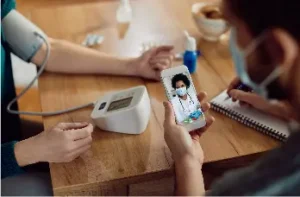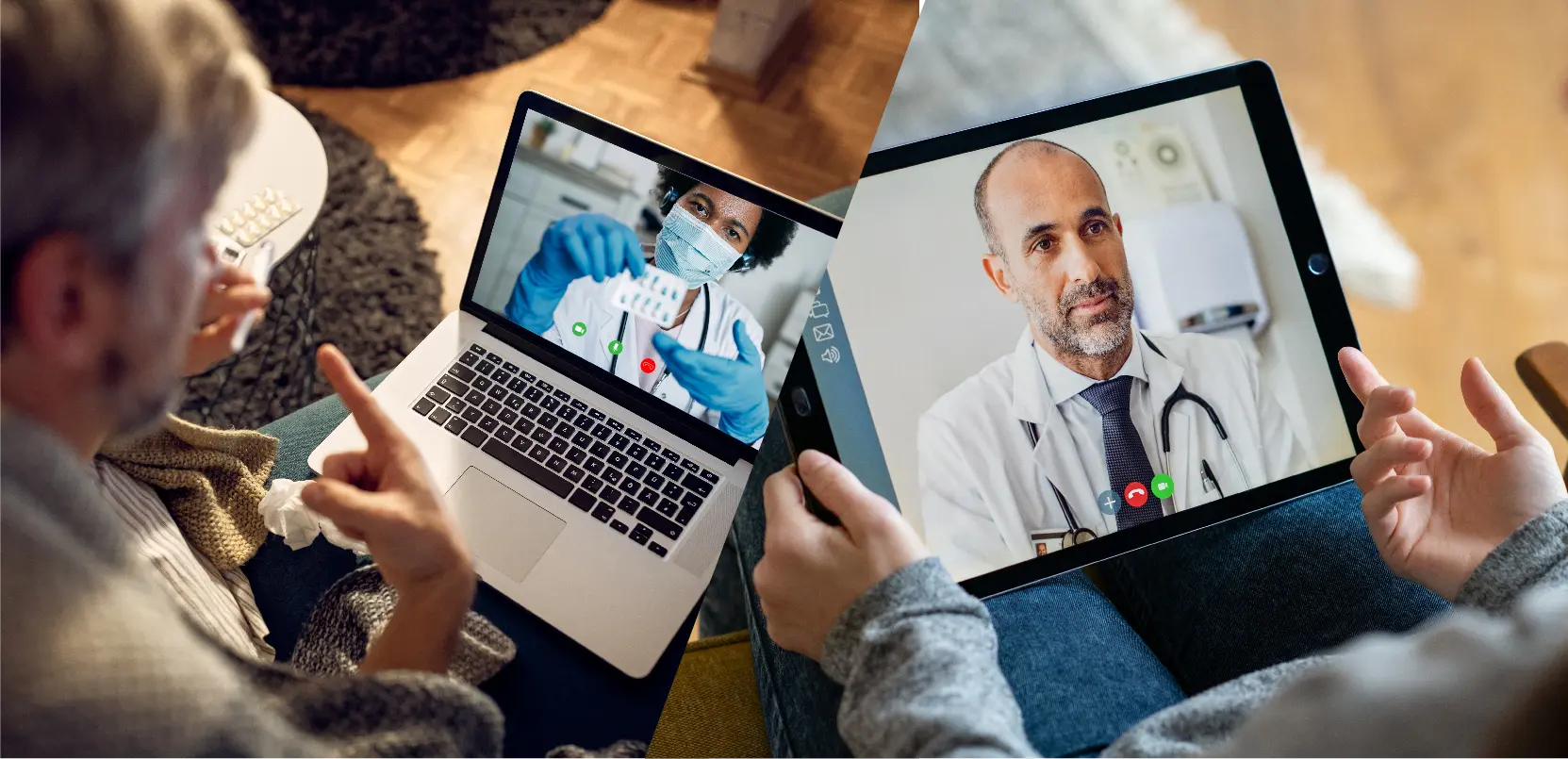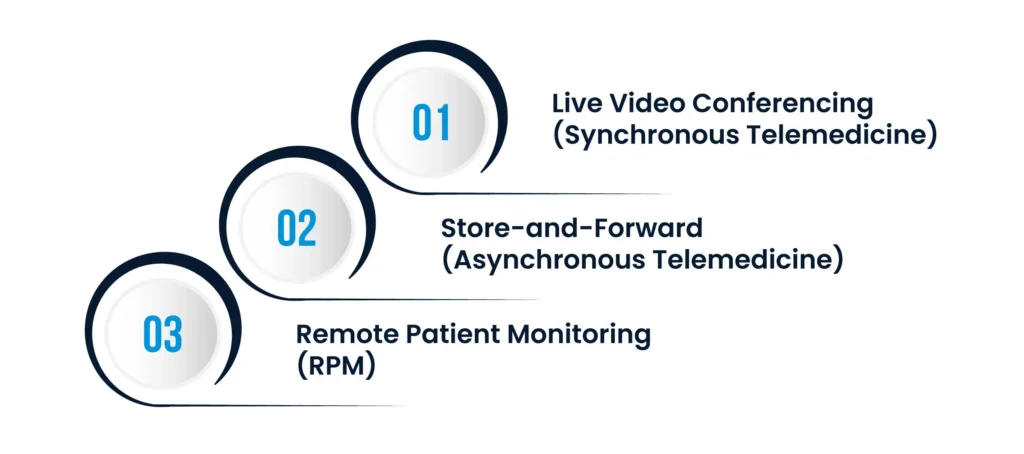

In the wake of the COVID-19 pandemic, healthcare providers have witnessed a significant shift in patient care delivery, with “telehealth” and “telemedicine” emerging as pivotal elements. This shift brings us to an essential question: What is the difference between telehealth and telemedicine?
Our blog today sheds light on “telemedicine vs telehealth,” particularly in the context of the healthcare delivery. Understanding these terms is more than academic; it’s about adapting to the new realities of healthcare delivery.
As we move through these changes, let’s explore together how each of these services has played a unique role during the pandemic and how they continue to shape the future of healthcare.
Join us on this insightful journey as we break down these concepts, ensuring you’re equipped with the knowledge to excel in this new era of digital medicine.
Telehealth encompasses a broad spectrum of technology-driven healthcare services and methods used to deliver care and education from a distance.
It is an umbrella term that includes telemedicine but extends beyond the clinical services to cover a wider range of remote healthcare activities.
Telehealth services can include remote monitoring of patients, provider training, non-clinical staff training, management and delivery of prescriptions, health education, and facilitating communication between healthcare providers.
The key aspect of telehealth is its focus on both clinical and non-clinical services, utilizing technology to improve healthcare delivery, patient education, and the overall efficiency of the healthcare system.
In essence, telehealth is the broader concept that aims to enhance healthcare accessibility, quality, and delivery through a variety of remote technologies and methodologies.
Telemedicine is a specific subset within the broader scope of telehealth. It focuses primarily on the clinical aspects of remote healthcare. Essentially, telemedicine involves the use of telecommunications technology to deliver medical services and consultations from a distance. This can include activities such as diagnosing and treating patients, conducting virtual consultations, and providing specialist services.
The key distinction lies in its clinical orientation – telemedicine is directly related to the patient’s clinical care, as opposed to the wider array of services encompassed by telehealth.

Telemedicine, a vital component of telehealth, can be categorized into several types based on how services are provided and the nature of the patient-provider interactions. Here are the primary types of telemedicine:
This is the most common form of telemedicine. It involves real-time, two-way interaction between a patient and a healthcare provider using audio-visual telecommunications technology. It’s used for consultations, follow-up visits, and in some cases, for providing certain types of therapy.
In this type, medical information (like images, biosignals, or voice recordings) is collected and then transmitted to a healthcare provider at a convenient time for assessment. It’s commonly used in dermatology (teledermatology), radiology (teleradiology), and pathology.
RPM allows healthcare providers to monitor patients’ health data remotely using various technological devices. This is particularly beneficial for patients with chronic conditions like diabetes, heart disease, or asthma. RPM can include the use of wearables that track vital signs, blood sugar levels, and other relevant health data.
The hierarchy of telehealth services can be visualized as a multi-layered structure, each level encompassing various aspects of healthcare delivery and education through technology. Here’s a breakdown:
Telehealth (Top Level): This is the broadest category, encompassing all forms of healthcare services and education delivered remotely through technological means. It’s the umbrella term under which all other services fall.
Telemedicine: This includes direct clinical services like consultations, diagnosis, and treatment provided remotely. It’s the most recognized aspect of telehealth, involving direct patient care.
Remote Patient Monitoring (RPM): RPM involves the use of digital technologies to monitor and capture medical and other health data from patients remotely. This data is then transmitted to healthcare providers for assessment and recommendations.
Provider Training and Continuing Medical Education: These are educational services for healthcare professionals, including webinars, online courses, and virtual conferences.
Professional Consultations: This includes non-clinical interactions among healthcare professionals, administrative meetings, and interdisciplinary team discussions.
Health Education Services for Patients: This layer involves patient education through online resources, virtual health education sessions, and other informational services aimed at improving patient health literacy.
Prescription Management and Delivery: This service includes electronic prescribing (e-prescribing) and management, as well as logistics for delivering medications to patients.
Provider-Provider Communication Tools: These are tools and platforms that facilitate communication and collaboration among healthcare providers, such as electronic health records (EHR) and teleconsultation platforms.
Understanding the difference between telemedicine and telehealth is pivotal for healthcare providers in the modern medical landscape. While these terms are often used interchangeably, they refer to distinct aspects of healthcare technology and services. To clarify the “telehealth and telemedicine difference,” a comparative table will highlight key distinctions between these two concepts, enabling a clearer understanding of what is the difference between telemedicine and telehealth, their applications, and their scope within the context of digital healthcare.
Aspect | Telemedicine | Telehealth |
Definition | Telemedicine specifically refers to remote clinical services. | Telehealth is a broader term encompassing all remote health services, including clinical and non-clinical. |
Scope | Focused on the diagnosis, treatment, and follow-up of patients remotely. | Includes health education, provider training, administrative meetings, and more, along with clinical services. |
Services Provided | Virtual consultations, remote diagnosis, e-prescribing, and specialist care. | Remote monitoring, tele-education, health information services, and telemedicine. |
Patient Interaction | Direct interaction with patients for their clinical care. | Can involve direct patient care or indirect services like health education. |
Healthcare Professional Involvement | Primarily involves doctors and medical specialists. | Includes a wider range of professionals like educators, administrators, and healthcare managers. |
Technology Used | Video conferencing, electronic health records, digital consultation platforms. | Same as telemedicine, plus additional technologies for education, training, and administrative purposes. |
To clarify the difference between telehealth and telemedicine further, let’s look at some practical examples:
Telemedicine Example:
A patient uses a video call to consult with their doctor about recurring headaches. The doctor assesses the patient’s symptoms, provides a diagnosis, and prescribes medication during the virtual appointment.
In this scenario, the focus is on the clinical interaction between the patient and the healthcare provider. The service is centered around diagnosis, consultation, and treatment, which are the core aspects of telemedicine.
Telehealth Example:
A diabetes patient regularly uploads their blood sugar readings through a mobile app, which their healthcare team monitors remotely. Additionally, the patient participates in an online diabetes education program provided by their healthcare provider.
Here, the services extend beyond direct clinical care. The patient is engaging in remote monitoring (telemonitoring) and educational services, both of which are components of telehealth. This example illustrates the broader scope of telehealth, encompassing both clinical and educational elements.
Telemonitoring is a specialized aspect within the broader realm of telehealth services, focusing on the remote monitoring of patients’ health.
It involves the use of various technological tools to remotely collect and transmit health data from patients to healthcare providers.
This aspect of telehealth is particularly valuable for managing chronic conditions, post-hospitalization care, and elderly care.
Telemonitoring typically includes devices like heart rate monitors, blood pressure cuffs, glucose monitors, and other wearable devices that track vital health metrics.
These devices send the collected data to healthcare professionals who can monitor and analyze the information in real-time or over a period of time.
This allows for timely interventions, adjustments in treatment plans, and more proactive management of a patient’s health.
The terms “Telehealth” and “Virtual Care” are often used interchangeably in the healthcare industry, but they have distinct meanings and encompass different scopes of service.
Telehealth: As previously discussed, telehealth is a broad term that encompasses the entirety of remote healthcare services and technologies. This includes clinical services (telemedicine), remote monitoring, health education, provider training, and administrative healthcare functions.
Telehealth is about leveraging technology to deliver and enhance healthcare services from a distance, covering a wide spectrum of activities from direct patient care to educational and administrative tasks.
Virtual Care: Virtual care is a subset of telehealth and refers more specifically to direct, real-time interactions between patients and healthcare providers over digital platforms.
It usually involves consultation, diagnosis, and treatment recommendations through video conferencing, chats, or phone calls. Virtual care is primarily focused on the clinical aspect of remote healthcare, emphasizing real-time communication and care.
In conclusion, understanding the nuances between telehealth and telemedicine is crucial for healthcare providers navigating the modern medical landscape. Telehealth serves as an umbrella term encompassing a broad range of remote healthcare services, including clinical and non-clinical activities like education and administration.
The emergence of telemonitoring and virtual care further expands the scope of digital health, offering enhanced patient care and greater accessibility. As we embrace these evolving technologies, it’s essential to recognize their distinct roles and applications, ensuring we can effectively integrate them into our practices to meet the changing needs of healthcare delivery.
Talk to an Expert Now